Physical Address
304 North Cardinal St.
Dorchester Center, MA 02124
The practice guideline for the standard obstetrical ultrasound examination identifies the four-chamber, left ventricular outflow tract (LVOT), and right ventricular outflow tract (RVOT) views as the minimum components in evaluation of the heart. Additional views are incorporated during dedicated fetal echocardiography and when an abnormality is suspected. Video clips are useful in documenting cardiac findings, facilitating assessment of cardiac motion. Doppler analysis is beneficial in detecting abnormal flow patterns in cardiac structures (e.g., regurgitation through valves and blood flow across septal defects). In the setting of a suspected cardiac abnormality, dedicated fetal echocardiography is often performed.
The four-chamber view is an axial view of the fetal thorax obtained at the level of the heart. Despite its name, the four-chamber view provides considerably more information about the heart than simply the number of chambers ( Box 16-1 ). Additional features that can be assessed include cardiac orientation and location in the thorax, overall heart size, relative size of the chambers to each other, chamber location, the interventricular and interatrial septa, and the foramen ovale. Video clips of the four-chamber view depict cardiac contractility and motion of the mitral and tricuspid valves.
Heart size, location, and orientation
Chamber size, number, and location
Interventricular and interatrial septa
Foramen ovale
Cardiac contractility
Location and motion of the tricuspid and mitral valves
It is important to identify the left and right sides of the fetus when assessing for normality of cardiac orientation and location. The location of internal organs such as the stomach should not be used to identify the right and left sides of the fetus. Although the assumption that the stomach is on the left is correct in most fetuses, applying this concept universally will result in an incorrect determination of fetal side in some fetuses with a situs abnormality. Instead, the right and left sides of the fetus should be determined by accounting for the location of the fetal head (cephalic, breech, transverse head right, and transverse head left) and fetal spine, which together define the anatomic right and left sides ( Fig. 16-1 ). Some examiners find it helpful to envision themselves lying with their head and spine in the corresponding orientation. Once the fetal left and right sides have been determined, the location of the stomach should be assessed; if the stomach is confirmed to be on the anatomic left side, it can be used to assign the left side of the fetus during the remainder of the examination, even after the fetus moves into a different position. On a four-chamber view of the heart, the cardiac apex should be on the same side as the fetal stomach. This can be confirmed by sliding the transducer superiorly to the thorax from an axial view of the stomach ( Fig. 16-2 ).
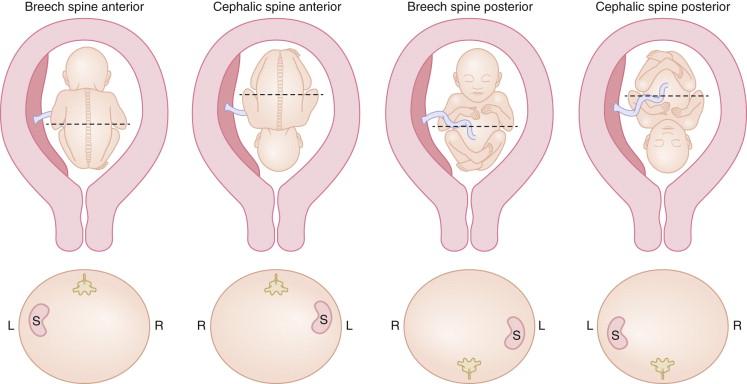
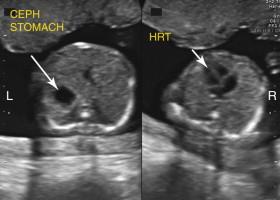
In the normal four-chamber view, the majority of the heart is located in the left hemithorax. The cardiac apex points toward the left side of the fetus at an angle of approximately 45 degrees from midline ( Fig. 16-3A ). The right ventricle is the anteriormost chamber (see Fig. 16-3B ). The left atrium is the posteriormost chamber and is located anterior to the descending aorta. The descending aorta is immediately anterior and slightly to the left of the spine. The size of the heart should be approximately one third to one half that of the thorax. The ventricles are similar to each other in size and account for approximately two thirds of the size of the heart. The atria are likewise similar to each other in size. The patent foramen ovale is visualized in the interatrial septum and the flap opens toward the left atrium (see Fig. 16-3C ). The right ventricle contains the moderator band, which is depicted as soft tissue in the apex of the right ventricle. The left ventricle has a smoother inner surface than the right ventricle. The mitral and tricuspid valves are distinct from each other, with a slight offset in location in which the tricuspid valve is located closer to the cardiac apex than the mitral valve (see Fig. 16-3D ). The valves open and close separately during the cardiac cycle ( ![]() ).
).
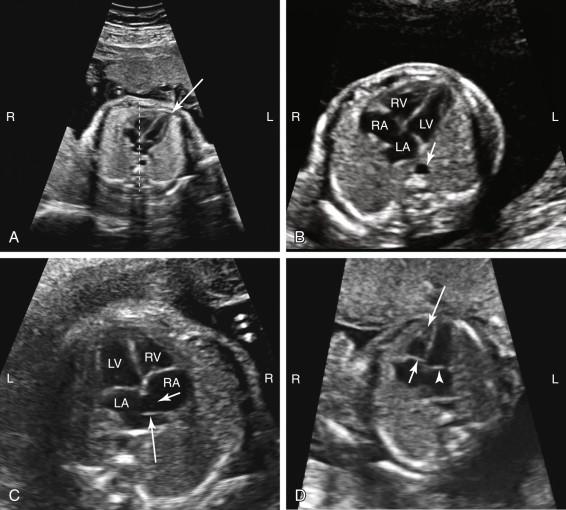
The LVOT view is a long-axis view of the left ventricle, depicting the left ventricular outflow arising from the left ventricle in the center of the heart. This view is obtained by tilting and rotating the transducer from the four-chamber view toward the fetal right shoulder. As on the four-chamber view, the anteriormost chamber is the right ventricle and the posteriormost chamber is the left atrium ( Fig. 16-4 ). The interventricular septum and the anterior wall of the ascending thoracic aorta are in continuity with each other.
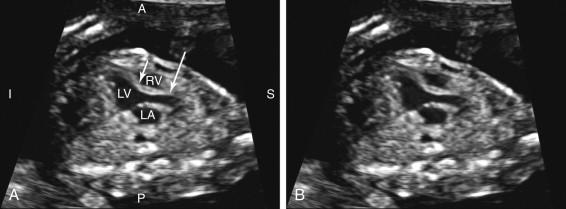
The RVOT view is obtained by turning the transducer further toward the fetal right shoulder from the left ventricular outflow tract view. This results in a longitudinal view of the RVOT, which should be in continuity with the pulmonary artery ( Fig. 16-5 ).
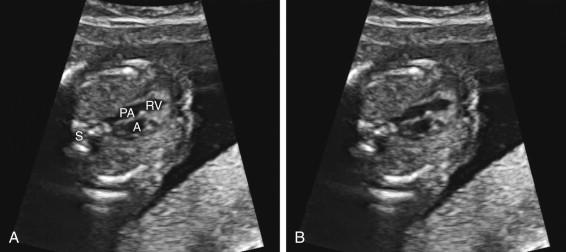
In addition to the views required for the standard obstetrical ultrasound examination, a short-axis view of the great vessels can be very helpful in screening for structural cardiac abnormalities. The short-axis view of the great vessels is obtained by moving the transducer cephalad from the four-chamber view and angling toward the fetal left shoulder ( Fig. 16-6 ). This view depicts the orientation of the origins of the pulmonary artery and the aorta to each other, and also demonstrates the RVOT. The aortic root is visualized in cross section in the center of the heart and the pulmonary artery is visualized originating from the RVOT and curving around the aorta on the left side of the heart. The right pulmonary artery and the patent ductus arteriosus, which extends from the main pulmonary artery posteriorly to the descending thoracic aorta, are also visualized in this view.
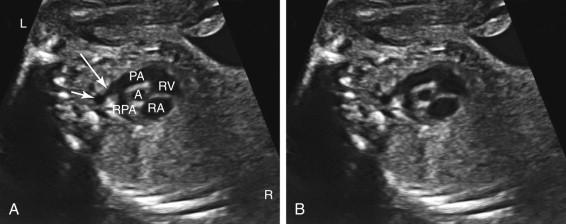
Although not required components of the standard obstetrical ultrasound examination, additional views, color Doppler, spectral Doppler, and M-mode imaging can be used to evaluate the fetal heart. Among the additional views used are a longitudinal view of the inferior vena cava and superior vena cava emptying into right atrium ( Fig. 16-7 ) and longitudinal views of the aortic arch and the ductal arch ( Fig. 16-8 ). The aortic arch is distinguished from the ductal arch by its curved shape (referred to as a candy-cane configuration) and identification of branches (innominate artery, left common carotid artery, and left subclavian artery) originating from the superior surface of the arch and coursing cephalad. The ductal arch is composed of the pulmonary artery and ductus arteriosus, and has a flattened configuration (referred to as a hockey-stick shape), with no branches arising from its superior surface.
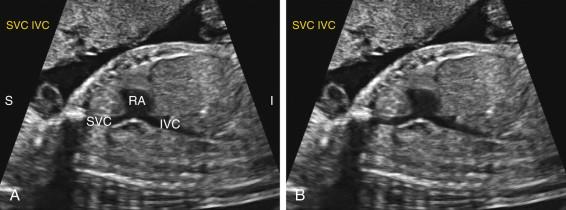
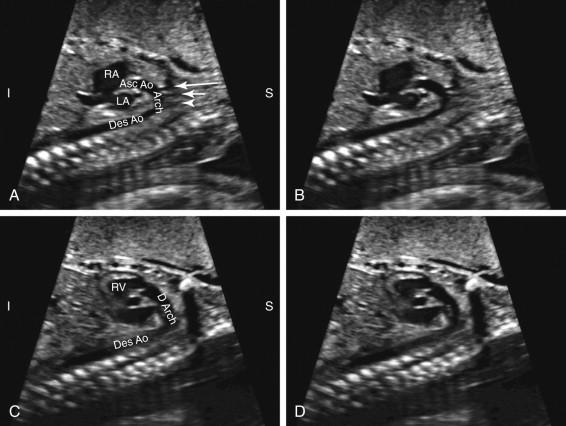
The four-chamber view is helpful in identifying ventricular ( Fig. 16-9A ) ( ![]() ) and atrioventricular (AV) septal defects. Doppler is useful in confirming a suspected ventricular septal defect (VSD), because it depicts flow through the defect (see Fig. 16-9B ;
) and atrioventricular (AV) septal defects. Doppler is useful in confirming a suspected ventricular septal defect (VSD), because it depicts flow through the defect (see Fig. 16-9B ; ![]() ). The four-chamber view can be acquired through an apical approach, in which the ultrasound beam is parallel to the interventricular septum, or a subcostal approach, in which it is perpendicular to the septum. On an apical view, the appearance of the interventricular septum may suggest a VSD due to attenuation of sound ( Fig. 16-10A and B ). This can be resolved by adjusting the scan plane, using Doppler to assess for flow, or obtaining a subcostal view (see Fig. 16-10C and D ). Most isolated atrial septal defects are not recognized at antenatal ultrasound because of the presence of a normal defect in the atrial septum, the patent foramen ovale.
). The four-chamber view can be acquired through an apical approach, in which the ultrasound beam is parallel to the interventricular septum, or a subcostal approach, in which it is perpendicular to the septum. On an apical view, the appearance of the interventricular septum may suggest a VSD due to attenuation of sound ( Fig. 16-10A and B ). This can be resolved by adjusting the scan plane, using Doppler to assess for flow, or obtaining a subcostal view (see Fig. 16-10C and D ). Most isolated atrial septal defects are not recognized at antenatal ultrasound because of the presence of a normal defect in the atrial septum, the patent foramen ovale.
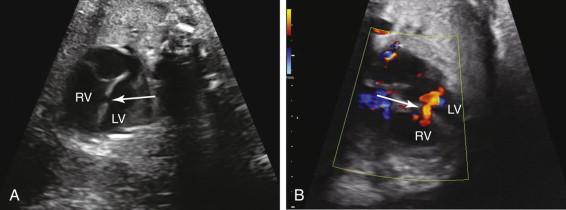
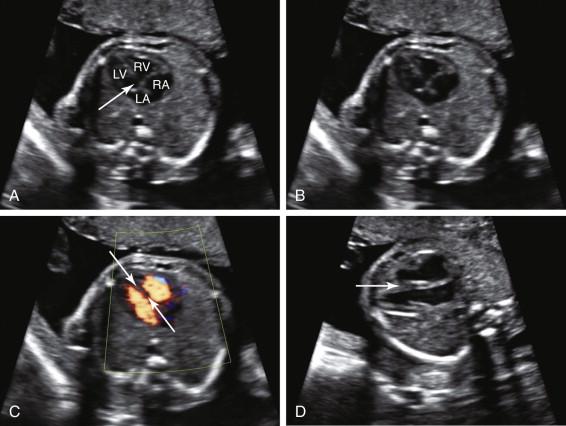
An AV septal defect (also called AV canal or endocardial cushion defect ) is characterized by a large defect in the center of the heart involving the interatrial septum and the interventricular septum, in conjunction with abnormality of the tricuspid and mitral valves. The most severe type of AV septal defect, a complete defect, has a common AV valve. The four-chamber view shows lack of the normally separate opening and closing of the mitral and tricuspid valves during the cardiac cycle ( ![]() ). The tricuspid and mitral valves do not exhibit the normally expected relationship in which the tricuspid valve is closer to the apex of the heart than the mitral valve. Instead the valves are located at the same level ( Fig. 16-11 ). AV septal defects are associated with a high incidence of aneuploidy (especially trisomy 21) and additional cardiac defects.
). The tricuspid and mitral valves do not exhibit the normally expected relationship in which the tricuspid valve is closer to the apex of the heart than the mitral valve. Instead the valves are located at the same level ( Fig. 16-11 ). AV septal defects are associated with a high incidence of aneuploidy (especially trisomy 21) and additional cardiac defects.
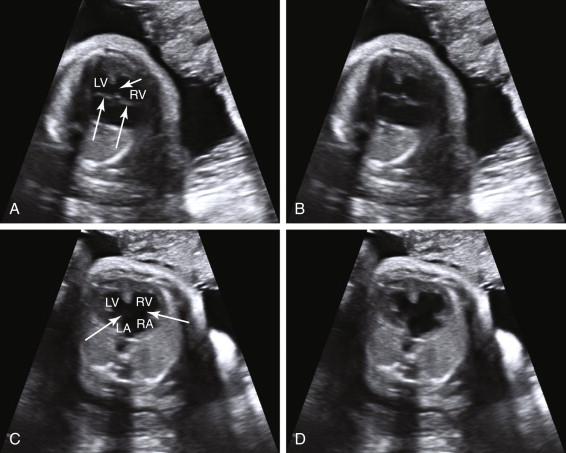
Become a Clinical Tree membership for Full access and enjoy Unlimited articles
If you are a member. Log in here